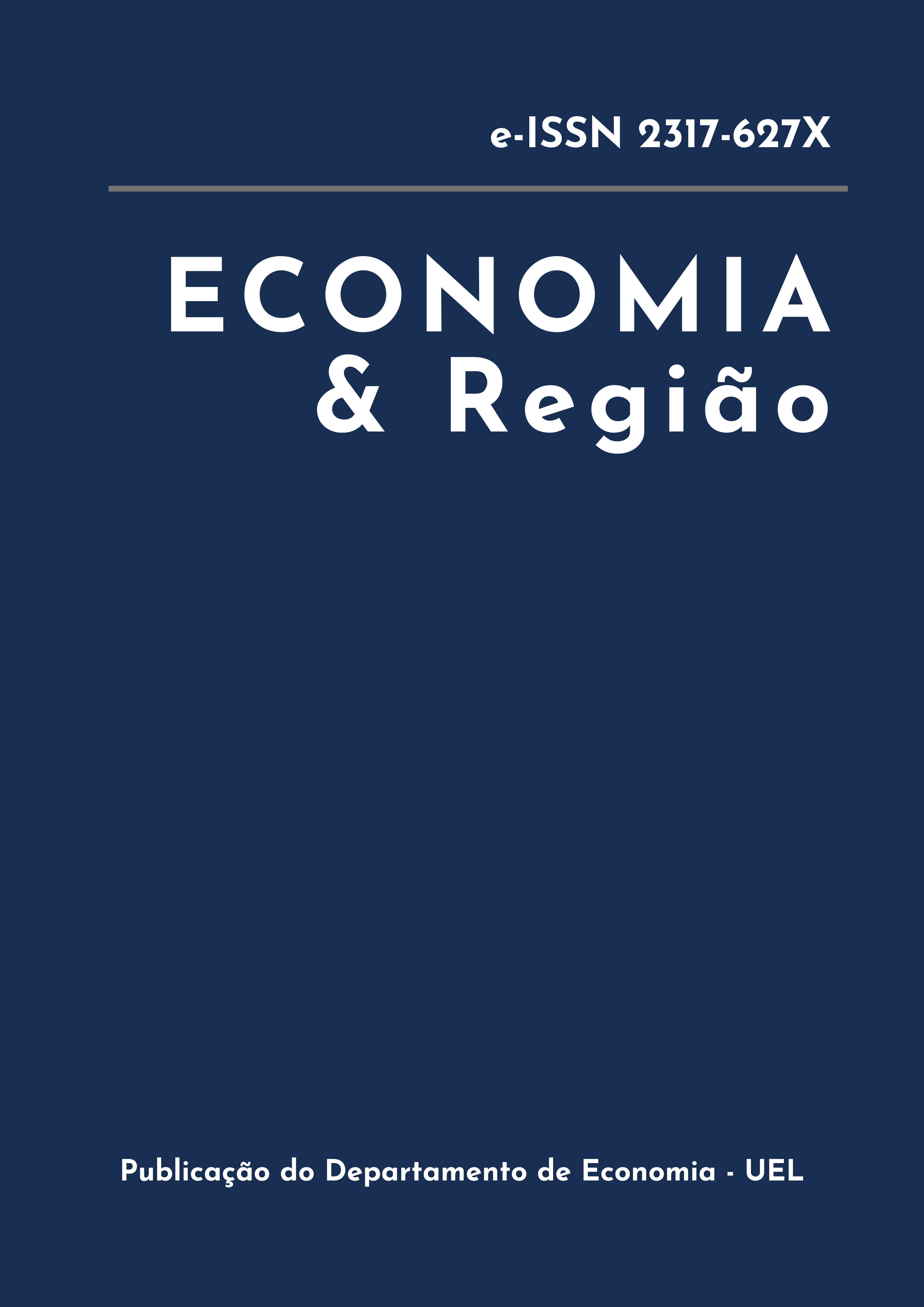Reflections of the Covid-19 pandemic on sectoral youth employment in the metropolitan regions of Cuiabá and Goiânia
DOI:
https://doi.org/10.5433/2317-627X.2024.v12.n1.48752Keywords:
Young, Labor Market, pandemic, Covid-19, Metropolitan RegionAbstract
The present study to analyze differences in the segmentation of youth employment in the years 2020 and 2021 in order to verify the possible consequences of Covid-19 in the Metropolitan Region of Vale do Rio Cuiabá (RMVRC) and Metropolitan Region of Goiânia (RMG). This article demonstrates, through the stratification of data from the Continuous National Household Sample Survey (PNADC) for the group of young people aged 14 to 29 years, the main regional differences and compares them with the empirical literature consulted. Considerable losses in the participation of young people within the labor market during the pandemic period are observed with emphasis on the commerce sector, which presented a reduction in the GMR of 7.2% and of 1.95% in the RMVRC. In terms of economic activities, the agricultural sector showed an increase in youth employment of 1.98% in the RMVRC, while for the RMG the increase was 1.24%. The industrial sector had a drop of 0.5% for the RMVRC region and an increase of 1.44% for the RMG. Other sectors such as Finance, Civil Construction, Education show divergences between the two analysis regions, indicating the importance of regional policies for the insertion and maintenance of young people in the labor market it is possible to perceive different impacts of Covid-19 in the two metropolitan regions.
Downloads
References
ANDRADE, F. R. B. Desigualdades e pandemia de COVID-19: contribuições para o debate sobre as particularidades sócio-históricas, educacionais e das juventudes do Brasil. Dialogia, n. 39, p. 1-14, set./dez. 2021. DOI: https://doi.org/10.5585/39.2021.20612
BARBOSA, F. de H. A crise econômica de 2014/2017. Estudos Avançados, São Paulo, v. 31, p. 51-60, 2017. DOI: https://doi.org/10.1590/s0103-40142017.31890006
BEZERRA, V. de L.; ANJOS, T. B. dos; SOUZA, L. E. S. de; ANJOS, T. B. dos; VIDAL, A. M.; SILVA JÚNIOR, A. A. da. SARS-CoV-2 como agente causador da COVID-19: Epidemiologia, características genéticas, manifestações clínicas, diagnóstico e possíveis tratamentos. Brazilian Journal of Health Review, São José dos Pinhais, v. 3, n. 4, p. 8452-8467, 2020. DOI: https://doi.org/10.34119/bjhrv3n4-097
BIAGIONI, D. Determinantes da mobilidade por classes sociais: teoria do Capital Humano e a teoria da segmentação do mercado de trabalho. In: ENCONTRO NACIONAL DE ESTUDOS POPULACIONAIS DA ABEP, 15., Caxambu, 2006. Anais [...]. Caxambu: ABEP, 2006. p. 1-19.
BORGES, B. K. Situação do mercado de trabalho juvenil nas principais regiões metropolitanas do país: breve análise. Indicadores Econômicos FEE, Porto Alegre, v. 41, n. 3, p. 101-108, 2014.
BRUNI, A. L. Estatística aplicada à gestão empresarial. São Paulo: Editora Atlas, 2007.
CAMACHO, A. C. L. F.; JOAQUIM, Fabiana Lopes; MENEZES, H. F. de
SANT’ ANNA, R. M. A tutoria na educação à distância em tempos de COVID-19: orientações relevantes. Research, Society and Development, Vargem Grande Paulista, v. 9, n. 5, p. 1-12, 2020. DOI: https://doi.org/10.33448/rsd-v9i5.3151
DOERINGER, P. B.; PIORE, M J. Internal labor markets and manpower analysis. Lexington, Mass: Heath Lexington Books, 1971
FARO, K. C.; FERRARINI, A. dos S. F. Emprego juvenil nas grandes regiões brasileiras: comparativo da reforma trabalhista (2017) com base nos microdados trimestrais da PNAD. In: ENCONTRO DA ABET, 27., 2021, Uberlândia. Anais [...]. Uberlândia: UFU, 2021.
FNEM – FORÚM NACIONAL DE ENTIDADES METROPOLITANAS. Região Metropolitana de Goiânia (GO). Disponível em: HTTPS://FNEMBRASIL.ORG/REGIAO-METROPOLITANA-DE-GOIANIA-GO/. Acesso em: 15 fev. 2022.
GUIMARÃES, N. A. Apresentação: os jovens brasileiros e o trabalho: desafios que se atualizam. Novos Estudos CEBRAP, São Paulo, v. 39, p. 465-473, 2021. DOI: https://doi.org/10.25091/s01013300202000030001
GUIMARÃES, N. A. Trajetórias juvenis: um novo nicho em meio à expansão das oportunidades de trabalho? Fortaleza: Editora IDT, 2013.
IBGE. Censo Demográfico 2010. Rio de Janeiro: IBGE, [2010]. Disponível em: https://www.ibge.gov.br/estatisticas/multidominio/cultura-recreacao-e-esporte/9662-censo-demografico-2010.html. Acesso em 5 de outubro de 2022.
IBGE. Contas regionais. Rio de Janeiro: IBGE, [2021]. Disponível em: Contas Regionais do Brasil | IBGE . Acesso em: 13 maio 2022.
IBGE. Glossário. Rio de Janeiro: IBGE, [2023]. Disponível em: https://ftp.ibge.gov.br/Trabalho_e_Rendimento/Pesquisa_Nacional_por_Amostra_de_Domicilios_continua/Mensal/glossario_pnadc_mensal.pdf. Acesso em: 23 set. 2023.
IBGE. Malha municipal. Rio de Janeiro: IBGE, 2022. Disponível em: Malha Municipal | IBGE. Acesso em: 10 mar. 2022.
IBGE. Síntese dos indicadores sociais: uma análise das condições de vida da população brasileira. Rio de Janeiro: IBGE, 2016. Disponível em https://biblioteca.ibge.gov.br/visualizacao/livros/liv98965.pdf. Acesso em: 25 maio 2022.
IBGE. Pesquisa Nacional por Amostra de Domicílios Contínua. Rio de Janeiro: IBGE, 2020. Disponível em: https://www.ibge.gov.br/estatisticas/downloads-estatisticas.html?caminho=Trabalho_e_Rendimento/Pesquisa_Nacional_por_Amostra_de_Domicilios_continua/Trimestral/Microdados/2020. Acesso em 16 de maio de 2022.
IBGE. Pesquisa Nacional por Amostra de Domicílios Contínua. Rio de Janeiro: IBGE, 2021. Disponível em https://www.ibge.gov.br/estatisticas/downloads-estatisticas.html?caminho=Trabalho_e_Rendimento/Pesquisa_Nacional_por_Amostra_de_Domicilios_continua/Trimestral/Microdados/2021. Acesso em 20 de maio de 2022.
IPEA. Governança Metropolitana no Brasil. Relatório de Pesquisa. Rio de Janeiro, 2015. Disponível em: https://www.ipea.gov.br/redeipea/images/pdfs/governanca_metropolitana/150814_relatorio_arranjos_valeriocuiba.pdf. Acesso em 20 de julho de 2022.
LIMA, R. Mercado de trabalho: o capital humano e a teoria da segmentação. Pesquisa e Planejamento Econômico, Rio de Janeiro, v. 10, n. 1, p. 217-272, 1980.
MATO GROSSO. Secretaria de Estado de Infraestrutura e Logística. Região Metropolitana do Vale do Rio Cuiabá. Cuiabá: SINFRA, 2017. Disponível em: https://www.sinfra.mt.gov.br/pddi#:~:text=O%20Plano%20Diretor%20de%20Desenvolvimento,Acorizal%20e%20Chapada%20dos%20Guimar%C3%A3es. Acesso em: 25 abr. 2022.
Ministério da saúde. Paniel Coronavírus. Dispositivo online. Disponível em:> https://covid.saude.gov.br/> Acesso em 17 de dezembro de 2023.
OIT – ORGANIZAÇÃO INTERNACIONAL DO TRABALHO. Trabalhadores jovens serão duramente atingidos pelas consequências econômicas da COVID-19. Brasília: OIT, 2020. Disponível em: https://www.ilo.org/brasilia/noticias/WCMS_741875/lang--pt/index.htm. Acesso em: 20 maio 2022.
OMT - OBSERVATÓRIO DO MUNDO DO TRABALHO. Estudo da Região Metropolitana de Goiânia: estudos e pesquisas economicas, sociais e educacionais sobre a região metropolitana de Goiânia. Goiânia: IFG, 2013. Disponível em:https://www.ifg.edu.br/attachments/article/493/regiao_metropolitana_de_goiania.pdf. Acesso em: 12 abr. 2022.
PEDROSO, P. R.; GISI, M. L. A pandemia–Covid 19 e os impactos na juventude: educação e trabalho. Revista Práxis, Volta Redonda, v. 12, n. 1, p. 185-194, jan./abr. 2020. Suplemento. DOI: https://doi.org/10.47385/praxis.v12.n1sup.3473
REICH, M.; GORDON, D. M.; EDWARDS, R. C. A theory of labor market segmentation. The American Economic Review, p. 359-365, 1973.
SILVA, D. F.; OLIVEIRA, M. L. C. Epidemiologia da COVID-19: comparação entre boletins epidemiológicos. Comunicação Em Ciências Da Saúde, Brasília, v. 31, p. 61-74, 2020.
SILVA, E. R. A. da; VAZ, F. M. Os Jovens que não trabalham e não estudam no Contexto da Pandemia da Covid-19 no Brasil. 2022. Repositório IPEA. Disponível em: https://repositorio.ipea.gov.br/handle/11058/12216> Acesso em 10 de março de 2023.
SINFRA. Região Metropolitana. Disponível em:> https://www.sinfra.mt.gov.br/sobre_regiao_metropolitana >. Acesso em: 5 fev. 2022.
SORENSEN, A. B. The structural basis of social inequality. American Journal of Sociology, v. 101, n. 5, p. 1333-1365, 1996 DOI: https://doi.org/10.1086/230825
SOUZA, M. C. C. de. Mercado de trabalho: abordagens duais. Revista de Administração de Empresas, São Paulo, v. 18, n. 1, p. 59-69, 1978. DOI: https://doi.org/10.1590/S0034-75901978000100006
SOUZA, G. B. P.; LORETO, M. das D. S. de; REIS, L. P. C. Crise dentro da crise: a inserção laboral juvenil e sua configuração no contexto do novo coronavírus. Oikos: Família e Sociedade em Debate, Viçosa, v. 32, n. 1, p. 90-108, 2021. DOI: https://doi.org/10.31423/oikos.v32i1.11341
THOMÉ, L. D.; TELMO, A. Q.; KOLLER, S. H. Inserção laboral juvenil: contexto e opinião sobre definições de trabalho. Paidéia (Ribeirão Preto), Ribeirão Preto, v. 20, p. 175-185, 2010. DOI: https://doi.org/10.1590/S0103-863X2010000200005
VIETORISZ, T.; HARRISON, B. Labor market segmentation: positive feedback and divergent development. The American Economic Review, p. 366-376, 1973.
ZHOU, S.; WANG, Y.; ZHU, T.; XIA, L. CT features of coronavirus disease 2019 (COVID-19) pneumonia in 62 patients in Wuhan, China. AJR. American journal of roentgenology. [New York], v. 214, n. 6, p. 1287-1294, 2020. DOI: https://doi.org/10.2214/AJR.20.22975
Downloads
Published
How to Cite
Issue
Section
License
Copyright (c) 2023 Ilriane Rafaela Ferreira Ribeiro, Angel dos Santos Fachinelli Ferrarini, Kelly Cardoso Faro

This work is licensed under a Creative Commons Attribution 4.0 International License.
Economia & Região adota a Licença Creative Commons Attribution CC-BY 4.0 International, portanto, os direitos autorais relativos aos artigos publicados são do(s) autor(es), que cedem à Revista Economia & Região o direito de exclusividade de primeira publicação.
Sob essa licença é possível: Compartilhar - copiar e redistribuir o material em qualquer suporte ou formato. Adaptar - remixar, transformar, e criar a partir do material, atribuindo o devido crédito e prover um link para a licença e indicar se mudanças foram feitas.
















